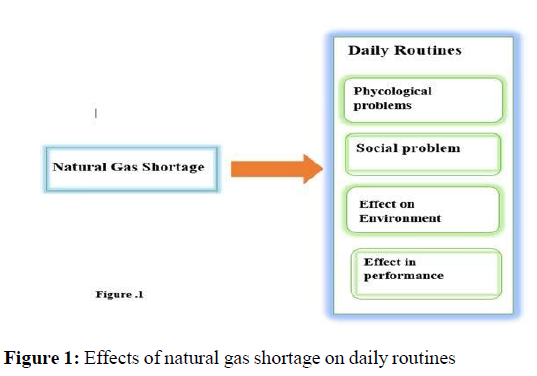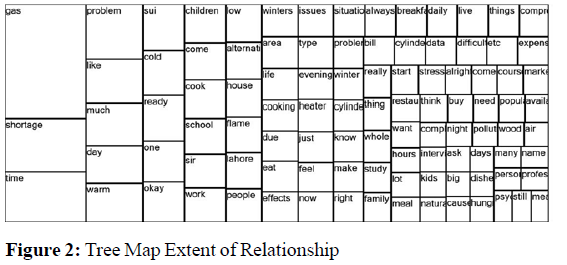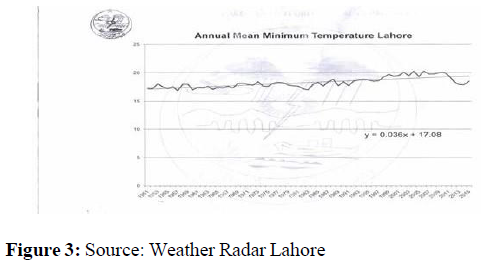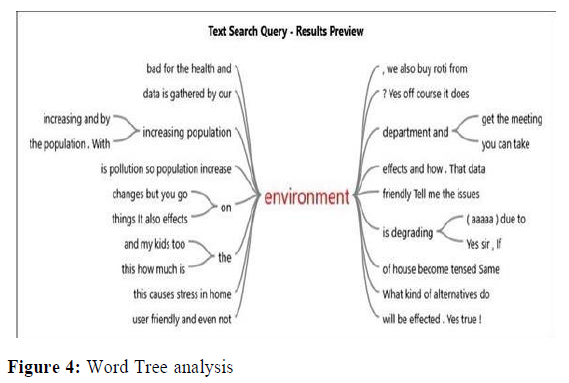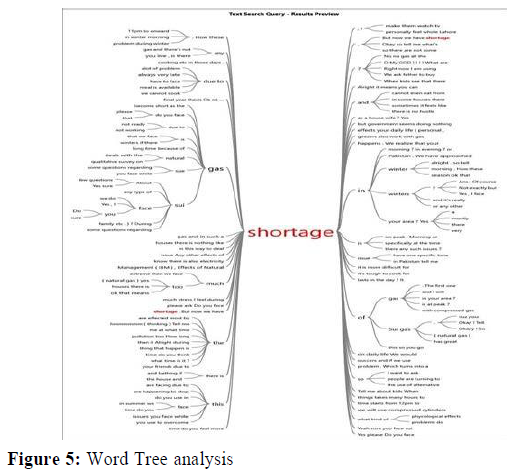Beginning of house quarrel: Qualitative Approach from Pakistan
Received: 02-Sep-2022 / Manuscript No. jescc-22-002 / Editor assigned: 05-Sep-2022 / PreQC No. jescc-22-002-PreQc / Reviewed: 09-Sep-2022 / QC No. jescc-22-002 / Revised: 16-Sep-2022 / Manuscript No. jescc-22-002-PreQc (R) / Accepted Date: 16-Sep-2022 / Published Date: 26-Sep-2022 DOI: 10.4172/2157-7617.1000642
Abstract
In this research the main target is to identify challenges faced by people due to gas shortage in their normal daily life routine. Pakistan is consuming natural gas from Sui since such a long time. Therefore, that is obvious to explore alternatives and understanding the challenges. Population of Islamic Republic of Pakistan is 213 million. Country is having limited resource of gas and this will encourage people to go for alternatives as they are struggling much from shortage. The study also discovers the physiological effects on the minds on people and the alternatives used by people and the effects of it on environment of these alternatives. sample is collected through recorded interviews from housewives, children, working men and students as well as focus groups are also being conducted as suggested by QSR – international (2012). This research also shows how people deviate from their professions because of shortage. Themes are derived from interviews; the number of interviews were 30. Focus group is also performed with employees of weather radar to check climatic conditions.
Keywords: Gas shortage; Physiological effect; Daily routine
Introduction
Need of energy in Pakistan is increasing every second [2]. Now Pakistan is on 6th position in the world in terms of population with 213 Million people (Pakistan Economic Survey 2018-2019). Primary energy source of the world is natural gas [12]. According to the forecast survey given EIA in 2015 shows that the consumption of energy will be increased by 56% in 2014 to 2040 [4]. By Shortage of natural gas in Pakistan is one of the non-ignorable problem now. Today environmental problems are striking us forcefully as compare to previous decade [4]. The prob- lems are threating living creatures and also causing climate change [4]. This worst problem is leading to many difficulties in daily routines of peoples. Natural gas is an important resource and its shortage can bring many problems in home chores, washing, cooking etc. Gas was also used as alternative of electricity but as the winter enters the shortage hits consumers badly. Shortage is seen from posh areas to slums of the country [17]. According to the natural northern gas pipelines limited (SNGPL) minister the shortfall of gas is 40 percent for domestic users last year and it will increase in coming years. That’s means the suffering would increase. if we talk about children 2 they wake up for school and experience cold water in winters for bathing then no breakfast on the table after studying all day in school’s colleges when they arrive home empty table will welcome them or the food from the restaurants would be served that’s expensive and not affordable for every one on daily ba- sis so they use coal and wood as alternatives and they badly effect our environment by damaging ozone layer and also causes health issues. According to Natusch and Waallace 1974, the small residue raises up in the air and become potentially hazardous because of their smaller size apart from children housewives suffer anxiety and males also get offended and the worst of it is mills cannot use their full capacity to produce things and brings inflation. Pakistan is going from the hard times natural attacks, inflation, electricity load shredding and unem- ployment but gas shortage is the one who is effecting every house every office every one of any age it is the physiological effect of being helpless that effects the consumers more than anything (DAWN) technical rea- sons are mentioned for this shortfall [13] according to Jostein Eikeland if we have capability to catch the energy from sunlight then it is enough to provide fuel to cars and energy for domestic use also but challenge is to capture it in such a way they it can be provided frequently to the consumers this study investigates the consequences caused by the shortage and its impact on their daily lives (Figure 1) . Research shows that people can get aware of the problems caused by energy sources in environment by education [6,1].
Literature review
Natural gas is known to be a primary energy for the world from the back few years [18] as it the cleanest burning fuel. Natural gas is very important as residential use, commercial use and commercial use. But in winters there is always a shortage of natural gas which results in darkness of commercial and industrial sectors it shortage also happens because of the technology that favours the use of natural gasnatural gas is not substituted yet in the developing countries like Pakistan have two major energy sources electricity and natural gas also known as suigas according to the energy system is characterized in long term de- velopment by high degree of uncertainty . Now the amount of use in future and further technology advancement only depends upon avail- able resources and its existence [3] but now resources of natural gas is limiting [8] Balochistan exploit 23 percent of the natural gas including 18 percent of the sui gas field as sui gas is the first largest field for gas in Pakistan natural gas was discovered in 1952 from sui as energy is always known for the fundamental thing for daily lives and energy is the main thing that effects daily lives it acts like a life line for economy and infrastructure but the shortage of natural gas is getting common and on its peak in winters it is mainly due to mismanagement , lack of long term strategic vision , carelessness , limitation in investment and also inadequate exploration of reserves “I feel difficulty when I cannot complete my home chores and I see my kids hungry when they came back to home from school asking for food” people of Pakistan are facing severe shortage of natural gas that is unscheduled and intol- erable from cooking to washing, bath to industrial use, home chores to transportation is badly jeopardized all the country is being against load shedding of 3 natural gas or sui northern gas pipeline limited (SNGPL) according to SNGPL the distribution of gas is 4.7 million commercial , domestic , industrial[9] . And the total demand raise by up to 40to 50 million cubic feet per day especially in winters it goes up to 100 mmcfd. and the shortage increases every year because of increase in population and so as the gas between demand and supply also increases and goes up to 2 million cubic feet per day and predicted to reach at 8.5 billion cubic feet per day In 2028 (Ogra) . Shahbaz and Feridun, 2012 said that the difference of supply and demand creates the energy crises according to Saeed Ghani senator, Sindh produces more natural gas 70% and the consumption at provincial stands at 45 percent. In 2016 according to Shahid Khaqan the minister of pe- troleum and natural resources Punjab have worst gas shortage in the history .as argued by Soherwordi (2010) household routine of Paki- stani people is disrupted[10]. “My husband fight with me when I do not prepare food on time ” people of Pakistan is living stress full live due to this shortage they are bound to use alternatives such as coal , wood , compressed gas cylinders , electronic roads etc. which have devastating effects on the human lives . the smoke from burning of coal and wood will directly goes to lungs and form cancer , respira- tory diseases , and heart diseases and as said by Environmental Protec- tion Agency of America (EPA ) smoke can affect every one teenagers, adults, children[11]. people with heart diseases and lung problems are more prone to it .the key feature of bronchial asthma and prevalence of allergic is due to air pollution new mothers or expected mothers should also take precautions to protect the health of their babies and themselves so it is crucial to distance yourself from smoke . air pollu- tion causes bad effect on human health pollution emitted by the sub- stitutes of natural gas also cause raise in climate temperature (weather Radar) the tiny particles in the air of wood smoke reduce the visibil- ity and also do esthetic damage in our scenic areas (EPA)[12]. People also have a perception that natural things are harmless and it is not absolutely true. Pollution in air and changes happened in climate are closely related to each other with applied scientific research. changes in climate and increase in pollution changes the soil which effects the forests and other processes like tea growth , compositions , fertility etc. Many pollutants like greenhouse gases (APS) interact with environ- ment chemically and also physically and the effect on climate varies region to region and also depends upon magnitude of climate and type of interactions (Bazzaz and Sombroek) “There are nationwide and lo- cal epidemiological studies showing that when particulate matter goes up premature deaths goes up, (Dr. Mathew Lakin) Thomas Hoffman argued that smoke is responsible for destroying our cells, trigger can-cer and can also led to death. Shortage of gas also disturb the lifestyle of people and led them to stress. Ann Pietrangelo analysed that every day responsibilities also triggers stress and negative life events like di- vorce, fights also results stress and anxiety same as shortage of sui gas or natural gas also interrupts in home chores and causes trauma and anxiety it also effects your CNS fight or flight response[13] it also caus- ing your muscle strain. (Figure 2)
Theoretical Framework
Research Methodology
For the research study there will be research design used as followsThe rationale of the study is in depth study that is why it is a in depth study[14]. The study is qualitative in nature as it produces rich under- standing, non-numerical and non –statistical data. This study is quali- tative in nature and follow interpretivist approach.
Research design
Nature of research is exploratory and qualitative so it follows the inter- pretivist approach and the aim of the study is to investigate the effects of natural gas shortage on daily routines of people and it also checks the effect of alternatives on environment case study method has been employed in this study. A well-known qualitative research approach is case study [15] explored that the case study method is mostly interest- ing when the studied phenomenon is not clearly or not sufficiently theorized, complex (Figure 3).
Unit of Analysis
The unit of analysis can be a an individual person who has had an understanding or is relevant to the study, individuals , groups or even a social process, an implementation process or can be an organization also the unit of analysis is individual for this research [16]. To perform this procedure semi-structured interviews including (Video, audio and documented) of 10-15 minutes has been taken to know outlooks and concerns of different people of Pakistan. According to Charmaz, 2006 NVivo can accommodate additional types of data (e.g. audio files, videos, digital photos, Word, PDF, rich text and plain text documents). This is a vital feature of the software because qualitative researchers are encouraged to remain open to new possibilities emerging from the data. (Figure 4)
Data Analysis
As argued by Ozkan (2004) explained that the qualitative research software NVivo is helpful for understanding and analysis but it is at rest the researcher’ attempt for data organizing, coding and analysis. So the analysis of this research is done through the same software to get accurate and unbiased results. According to Hutchison, Johnston, & Breckon, 2010 the most powerful tool to analyze qualitative research study is QSR Nvivo , it can facilitate in many aspects of the qualitative data processing from the design, through to the analysis of data, theo- retical and presentation of findings of study . apart from this thematic analysis is also applied to draw out many themes related to study and concerned problem. for this purpose Nvivo features help a lot to draw different themes to explore the interpretation in the project [5].
Word tag cloud that is shown above inis depicting different themes from this study like shortage, gas, cold etc. the themes are shown ac- cording to their repetition frequency in this qualitative study more repetition is shown in bolder text. Figure: 3 shows word tree analysis it creates the linkages of a major word of the research i.e. Shortage of Gas it also shows the significance of each and every node of the data (Figure 5).
The figure below is the Tree map it is used to show the consequences in the transcribed data [5]. it shows the impact of daily lived of the people, using of alternatives, shortage of gas in winters, effect of these alternatives and other consequences.
Impact on Climate and Raise in Temperature
Pollution emitted from alternatives of gas such as coal and wood, as coal is known as the most harmful recourse to environment the major emission of carbon monoxide in environment comes from coal causes raise in climate change and raising of temperature in Pakistan[17] looking at past decade it is estimated that the ratio of rainfall have increased and winters time period become very short as compare to summers.
Limitations and Recommendation
Like many other good researches this research also have limitations. This study is bound in the boundary of Pakistan. This research throw light on the gas shortage and exclude other energy shortages in Paki- stan. Future researchers can concentrate on new ideas to explore more sources of energy[18] they can also touch the gap to overcome this shortage efficiently. Other researchers will also research on the con- nection between rainfall and pollution produced by alternatives.
Conclusion
This research study investigates the effects and consequences of impact of natural gas shortage on daily lives and climate of Pakistan. for this research data has been collected through interviews and focus group and it is analysed on QSR Nvivo interviews are 8 taken from house wife’s and children and climate change interviews are taken from La- hore weather Radar. Study have showed different factors and after ana- lysing it is showed that shortage of natural gas have a major impact on daily routine of people, everyone is suffering including house wives, children, working men and the pollution produced by the alternatives of gas results in depletion of ozone layer and raise in temperature. The causes of shortage include inefficient management, lack of strategic planning, less focus on rural areas. Future researchers can explore the more reasons of it and more factors contributing in rise of tempera- ture.
References
- Saygın H, Oral, HV, Kardaşlar S (2020) Environmental assessment of renewable energy scenarios for a sustainable future in Turkey. Energy Environ 31(2), 237–255.
- Irfan M, Zhao ZY, PanjwaniMK, Mangi FH, Li H, et al (2020) Assessing the energy dynamics of Pakistan: Prospects of biomass energy. Energy Reports 6:80-93.
- D'Amato G, Cecchi L, D'amato M, Liccardi G (2010) Urban air pollution and climate change as environmental risk factors of respiratory allergy: an update. J Investig Allergol Clin Immunol 20(2):95-102.
- Bytnerowicz A, Omasa K, Paolette E (2007) Integrated effects of air pollution and climate change on forests: a northern hemisphere perspective. Environ Pol 147(3):438-445.
- Lodhi RN, Malik RK (2013) Impact of electricity shortage on daily routines: A case study of Pakistan. Energy Environ 24(5):701-709.
- Fichtenberg CM, Glantz SA (2002) Effect of smoke-free workplaces on smoking behaviour: systematic review. Bmj 325(7357):188.
- Islam MR, Islam MR, Beg MRA (2008) Renewable energy resources and technologies practice in Bangladesh. Rene Sustain Ener Rev 12(2):299-343.
- Mekhilef S (2010) Renewable energy resources and technologies practice in Malaysia. 23-25.
- Ramanathan V, Feng Y (2009) Air pollution, greenhouse gases and climate change: Global and regional perspectives. Atmos En- viron 43(1):37-50.
- Denny EA (1996) The competition between coal and natural gas the importance of sunk costs. Res Policy 22(1–2):33-42.
- Lin WT, Chen YH, Chatov R (1987) The demand for natural gas, electricity and heating oil in the United States. Res Energy 9(3):233-258.
- Dale H, Brassington L, King K (2014) The impact of healthy lifestyle interventions on mental health and wellbeing: A systematic review. Mental Health Rev J 19(1):1–26.
- Barratt C, Green G, Speed E (2015) Mental health and houses in multiple occupation. J Pub Mental Health 14(2):107–117.
- LaRocco J, House J, John RP, French JR (1980) Social Support, Occupational Stress, and Health. J Health Soc Behav 21(3):202218.
- Delongis A, Folkman S, Lazarus RS (1988) The impact of daily stress on health and mood: psychological and social resources as mediators. J pers soc psyc 54(3): 486.
- Page AL, Ahmed EA, Straughan IR (1979) Physical and chemical properties of fly ash from coal fired power plants with referance to enviromntal impact. 71:83-120.
- Lin H (2014) Government–Business Partnership Formation for Environmental Improvements. Org Environ 27(4):383-398.
- Bell SE, York R (2012) Coal, Injustice, and Environmental Destruction: Introduction to the Special Issue on Coal and the Environment. Org Environ 25(4):359-367.
Indexed at, Google Scholar, Crossref
Indexed at, Google Scholar, Crossref
Indexed at, Google Scholar, Crossref
Indexed at, Google Scholar, Crossref
Indexed at, Google Scholar, Crossref
Indexed at, Google Scholar, Crossref
Indexed at, Google Scholar, Crossref
Indexed at, Google Scholar, Crossref
Indexed at, Google Scholar, Crossref
Indexed at, Google Scholar, Crossref
Indexed at, Google Scholar, Crossref
Indexed at, Google Scholar, Crossref
Indexed at, Google Scholar, Crossref
Indexed at, Google Scholar, Crossref
Indexed at, Google Scholar, Crossref
Indexed at, Google Scholar, Crossref
Citation: Ahmad S (2022) Beginning of house quarrel: Qualitative Approach from Pakistan. J Earth Sci Clim Change Syst.13:634 DOI: 10.4172/2157-7617.1000642
Copyright: © 2022 Ahmad S. This is an open-access article distributed under the terms of the Creative Commons Attribution License, which permits unrestricted use, distribution, and reproduction in any medium, provided the original author and source are credited.
Select your language of interest to view the total content in your interested language
Share This Article
Recommended Journals
Open Access Journals
Article Tools
Article Usage
- Total views: 3159
- [From(publication date): 0-2022 - Nov 26, 2025]
- Breakdown by view type
- HTML page views: 2709
- PDF downloads: 450

